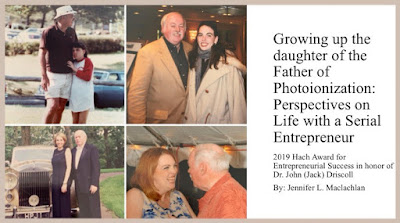Date: Monday, April 1, 2019
Location: Hilton Orlando, Room: Orlando V
Time: 1pm-4:30pm Reception immediately following the program
Award Address (Kathryn C. Hach Award for Entrepreneurial Success sponsored by the Kathryn C. Hach Award Fund)
Photoionization detector for gas chromatography: From inception and PPB analysis of VOC’s to PPT analysis of heavy metals
John N. Driscoll, pidguy@aol.com, Jennifer L. Maclachlan, pidgirl@gmail.com. PID
Analyzers, LLC, Centerville, Massachusetts, United States
The 2019 Kathryn C. Hach awardee, Dr. Jack Driscoll will share his experience with
photoionization, which began in 1967 with a program on a NASA project, "A
Photoionization Mass Spectrometer for Contaminant Gases in Space Cabin
Atmospheres”. The project was successful but was not renewed. The technique was
very interesting to Driscoll and he felt that it had excellent potential as an analytical tool.
The work continued a number of years later when he started HNU Systems to develop
photoionization based analyzers for industrial hygiene and gas chromatography
markets. His company sold more than 50,000 of these analyzers. Recently Driscoll
discovered that the PID could be used with hydride generation coupled to GC/PID to
detect ppb levels of many heavy metals in food, water, juices, etc. The technique was
applied to detection of ppt levels of Hg using a gold amalgam to concentrate samples
specifically for Hg. The PID remains as a very sensitive technique for the analysis on
VOC’s and heavy metals and he will discuss the results and analytical impacts of these
measurements.
Growing up the daughter of the father of photoionization: Perspectives on life with a serial entrepreneur
Jennifer L. Maclachlan, pidgirl@gmail.com. PID Analyzers, LLC, Centerville,
Massachusetts, United States
Dr. Jack Driscoll is the 2019 Kathryn C. Hach Award for Entrepreneurial Success
awardee and his daughter and business partner, Jennifer Maclachlan, will share
anecdotes of growing up Driscoll: With a father who pioneered the life saving hand-held
photoionization detector in the 1970's, acquired numerous analytical instrumentation
companies including European businesses, started and remains on the board of
directors of the world's largest privately-held in-vitro diagnostics company, a passionate
advocate for education, an avid science fiction fan and a beloved volunteer to the
Northeastern Local Section of the American Chemical Society.
Oceanographic applications for photoionization detection
Gregory A. Cutter, gcutter@odu.edu. Old Dominion Univ, Norfolk, Virginia, United
States
Chemical oceanography studies the chemistry of the planet’s oceans in relation to their
physics (circulation), geology (sources of materials), and biology. These studies include
organic, inorganic, and physical chemistry aspects. However, seawater is a high ionic
strength medium whose constituents besides the major ions that make up salinity, are
at micro- to femptomolar concentrations. This imposes substantial analytical problems.
In addition to low concentrations, many constituents are volatile (e.g., dimethyl sulfide)
or unstable with storage (e.g, FeII), necessitating determinations at sea – consider your
lab moving constantly in 3 dimensions. The photoionization detector coupled primarily
with gas chromatography is ideally suited for chemical oceanography due to its small
size, limited need for specialized compressed gases, simple and robust construction,
and extremely low detection limits for a variety of inorganic and organic molecules. This
talk will illustrate these features using the shipboard determinations of hydrogen sulfide
and metalloid chemical speciation as examples.
Arthur Obermayer and the billion-dollar SBIR program
John N. Driscoll, pidguy@aol.com, Jennifer L. Maclachlan, pidgirl@gmail.com. PID
Analyzers, LLC, Centerville, Massachusetts, United States
The Small Business Innovative Research program (SBIR) which sets aside 1.7% of 12
Government Agencies R&D budget for small businesses was initiated by the work of Dr.
Arthur Obermayer and Senator Kennedy. Obermayer’s Company, Moleculon, received
the first SBIR Grant from the NSF in 1982 for $25,000. Obermayer worked with Bush
and Dole to ensure that the patent rights went to the Company that developed the
product and not to the government. Obermayer continued to work with Kennedy and
other congressmen to expand this program to other agencies and their R&D budgets. In
2018, the SBIR/STTR program budget was $2.3 billion dollars. The total amount spent
of SBIR/STTR was $50 billion dollars. The impact that this has had on small chemical
businesses and the technology workforce will be addressed.





No comments:
Post a Comment